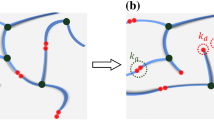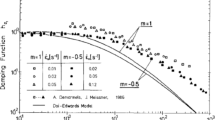Abstract
A reptation model for the primitive chain that does not assume independent alignment or consistent-averaging for the retraction process, or equilibrium relaxation for the reptation process is proposed and compared to the analytical expressions of Doi and Edwards in single-step, double-step strains and steady-state shear flow. The Doi and Edwards model with independent alignment approximation underpredicts the magnitude of the relaxation modulus by 25%, and consistently overpredicts the magnitude of the damping function; for steady shear flow, it predicts the correct shape for the steady-state viscosity and the first normal stress difference coefficient, although the magnitude is incorrect. The analytical expressions of Doi and Edwards without independent alignment approximation are excellent approximations to the damping function. In double-step strains, the expressions of Doi assuming consistent averaging, but no independent alignment, predict well the stress decay following the second strain. Linear response theory is found to be invalid for describing the stress relaxation following single-step strain for the models considered. Similar to the Doi and Edwards model, no overshoot for the first normal stress difference is observed for the simulation model. Unlike the Doi equation derived without the independent alignment approximation but restricted to double-step strains, the simulation model proposed here can be easily generalized to complex flow fields. No contour length fluctuation or constraint release is considered in this model, and chain retraction is assumed to be instantaneous.
Similar content being viewed by others
References
Abramowitz M, Stegun IE (1964) Handbook of Mathematical Functions. National Bureau of Standards, Washington DC
Bird RB, Stewart WE, Lightfoot E (1960) Transport Phenomena. John Wiley, New York
Bird RB, Ottinger HC (1992) Transport properties of polymeric liquids. Ann Rev Phys Chem 43:371–406
Brown EF, Burghardt WR (1996) First and second normal stress difference relaxation in reversing double-step strain flows. J Rheol 40:37–54
Doi M (1980) Stress relaxation of polymeric liquids after double step strain. J Polym Sci Polym Phys Ed 18:1891–1901
Doi M, Edwards SF (1978a) Dynamics of concentrated polymer systems. Part 1. Brownian motions in the equilibrium state. J Chem Soc Faraday Trans II 74:1789–1800
Doi M, Edwards SF (1978b) Dynamics of concentrated polymer systems. Part 2. Molecular motion under flow. J Chem Soc Faraday Trans II 74:1802–1817
Doi M, Edwards SF (1978c) Dynamics of concentrated polymer systems. Part 3. The constitutive equation. J Chem Soc Faraday Trans II 74:1818–1832
Doi M, Edwards SF (1986) The Theory of Polymer Dynamics. Clarendon Press, Oxford
De Gennes PG (1971) Reptation of a polymer chain in the presence of fixed obstacles. J Chem Phys 55:572–579
Einaga Y, Osaki K, Kurata M, Kimura S, Tamura M (1971) Stress relaxation of polymer solutions under large strains. Polymer Journal 2:550–552
Fukuda M, Osaki K, Kurata M (1975) Nonlinear viscoelasticity of polystyrene solutions I. Strain-dependent relaxation modulus. J Polym Sci Polym Phys Ed 13:1563–1576
Graessley WW (1980) Some phenomenological consequences of the Doi-Edwards theory of viscoelasticity. J Polym Sci Polym Phys Ed 18:27–34
Hua CC, Schieber JD (1997) Viscoelastic flow through fibrous media using the CONNFFESSIT approach (submitted to J Rheol)
Kubo R, Toda M, Hashitsume N (1985) Statistical physics II: Nonequilibrium statistical mechanics. Springer, Berlin
Lodge TP, Rotstein NA, Prager S (1990) Dynamics of entangled polymer liquids: Do linear chains reptate? Adv Chem Phys 79:1–132
Osaki K, Kimura S, Kurata M (1981) Relaxation of shear and normal stresses in double-step shear deformations for a polystyrene solution. A test of the Doi-Edwards theory for polymer theology. J Rheol 25:549–562
Osaki K, Nishizawa K, Kurata M (1982) Material time constant characterizing the nonlinear viscoelasticity of entangled polystyrene systems. Macromolecules 15:1068–1075
Öttinger HC (1989) Computer simulation of reptation theories I. Doi-Edwards and Curtiss-Bird models. J Chem Phys 91:6455–6462
Schieber JD (1990) The effect of finite link number on reptation models. J Non-Newtonian Fluid Mech 36:205–242
van Kampen NG (1993) Stochastic Processes in Physics and Chemistry. North-Holland, Amsterdam
Venerus DC, Kahvand H (1994) Normal stress relaxation in reversing double-step strain flows. J Rheol 38:1297–1315
Author information
Authors and Affiliations
Rights and permissions
About this article
Cite this article
Hua, C.C., Schieber, J.D. & Andrews, N.C. A constant-contour-length reptation model without independent alignment or consistent averaging approximations for chain retraction. Rheol Acta 36, 544–554 (1997). https://doi.org/10.1007/BF00368132
Received:
Accepted:
Issue Date:
DOI: https://doi.org/10.1007/BF00368132




